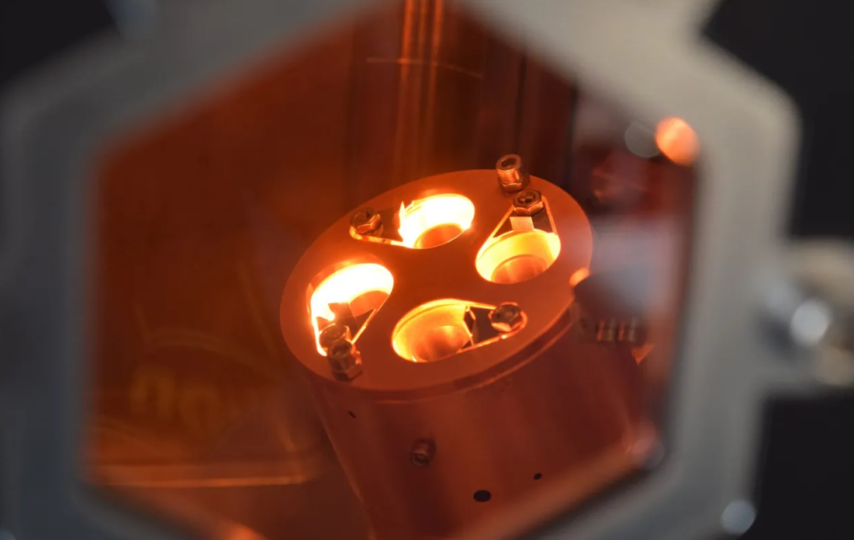Have you ever wondered how the screens on our phones or the special coatings on our glasses are made so precisely? Well, one important method is called “E-Beam Evaporation”.
It’s kind of like an extremely accurate painting technique, but instead of using brushes, it employs beams of electrons to meticulously apply thin layers of various materials onto surfaces.
But what makes this technique so special? Let us explore five key reasons why Electron Beam Evaporation has become essential for ensuring the technology that we use daily, such as our phones and even vehicles, functions effectively and efficiently.
What is E-Beam Evaporation?
Electron Beam Evaporation/ E-Beam Evaporation is a complex technology used in the Physical Vapour Deposition (PVD) process to coat thin layers of diverse materials on surfaces.
The core components of the E-Beam Evaporation process include:
- Vacuum Room: The process happens in a space without air to stop any dirt from getting in, ensuring the thin layers put on materials are high quality.
- Electron Beam Source: The filament is made up of Tungsten that can be heated to high temperatures such as 2000 degree Celcius to emit electrons.
- Magnetic Fields: These tools help shape and guide the electron beam toward the material we want to turn into vapor, which is held in a container called a crucible. The magnetic fields make sure the electron beam stays focused and strong.
- Crucible: The container that holds the material we’re turning into vapor. It can be made of different stuff depending on how hot it needs to get. The container is also cooled with water to keep the material pure and in good shape while we’re working with it.
- Substrate: The material where the vapor particles land to create the thin layer. Substrates can be of different materials like metals, ceramics, or glass.
How E-Beam Evaporation Works?
During the E-Beam Evaporation process, the electron beams generated by the source are directed towards the material in the crucible. The energy from the electron beam evaporation system heats the material until it evaporates. These tiny particles move through the empty space in the chamber and stick to the surface, making a thin layer.
E-Beam Evaporation lets us put super clean materials onto surfaces at just the right speed. We can use it to evaporate different materials, even really tough metals and mixtures. Plus, it keeps an eye on how thick the layer is getting as it goes, so we can control it really well.
Key Advantages of E-Beam Evaporation:
E-Beam Evaporation offers several distinct benefits:
High Material Utilisation Efficiency
E-Beam Evaporation is great because it doesn’t waste much material. Other ways of putting stuff on things can waste a lot, but with E-Beam, it uses a focused beam to turn the material straight into vapor without spreading it too much.
This means less waste and cheaper production, which is good for the environment and saves money.
Ability to Deposit Complex Materials
E-Beam Evaporation excels in depositing complex materials with unparalleled precision. Traditional methods often need help with materials that require specific conditions for deposition. E-beam evaporation uses a directed electron beam to precisely melt and evaporate complex materials, creating advanced multi-layer structures.
This capability opens doors to innovative applications in industries requiring high-purity films with complex compositions.
Precise Thickness and Composition Control
E-Beam Evaporation is super precise in making sure the layers it puts on things are just right. Technicians can tweak how strong the electron beam is and how fast the material turns into vapor to control the thickness of the layer down to tiny levels.
Less Heat Impact on Substrates
E-Beam Evaporation doesn’t make things too hot. Other methods heat up everything around, which can harm sensitive materials. But with E-Beam, the heat only affects the material being evaporated, keeping sensitive stuff safe.
Versatility and Scalability
E-Beam Evaporation can be used for all sorts of things, from tiny lab tests to big factory jobs. It’s flexible and can handle different materials and sizes. So, whether you’re doing experiments or making lots of stuff, E-Beam can adjust to what you need.
Applications of E-Beam Evaporation in Industry
Aerospace and Automotive
E-Beam Evaporation adds strong layers to parts, making them tough enough for rough conditions. It’s used in planes and cars to make sure parts stay strong and work well, especially when they face a lot of wear and tear or tough environments.
Devices for Seeing and Light
E-Beam Evaporation is a fancy way to make lenses, mirrors, and thin coatings for things like glasses. It’s super important for making optical devices work really well. Plus, it helps make solar panels better at turning sunlight into energy.
Chips and Gadgets
E-Beam Evaporation is really important in making electronics because it puts layers on tiny chips to make them work. It’s a popular choice because it can make really delicate layers that are the same all over and really clean, which is super important for making high-tech electronic parts.
Pretty and Tough Layers
E-beam evaporation, a technique to apply coatings on items such as jewelry and architectural glass. This can improve their look while increasing their resistance to scratches and rust. So that it becomes more durable.
These coatings on architectural glass can also aid in reflecting infrared light and keep indoor temperatures stable, enhancing energy efficiency.
Medical Devices
In the medical industry, E-Beam Evaporation deposits biocompatible materials onto medical devices.
These coatings can improve the durability and functionality of devices such as stents, implants, and surgical tools, ensuring they perform effectively and safely in medical procedures.
Research and Development
Beyond commercial applications, E-Beam Evaporation is used extensively in research settings to develop new materials and coatings. Scientists and engineers utilize this technology to experiment with novel thin-film compositions and structures, leading to advancements in various fields, including nanotechnology, energy storage, and material science.
Wrapping Up
E-Beam Evaporation is changing how we put thin layers of stuff onto things, making it super efficient, precise, and flexible. This is a big deal for industries like aerospace and medical devices because it lets us put tricky materials on things really accurately, wasting less and making things better.
It’s helping us come up with new and better stuff in lots of different areas where the type of materials we use is really important for what we can make.








